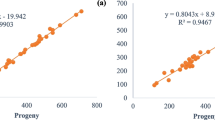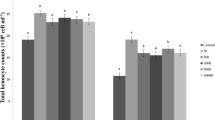Abstract
Larvae of parasitic IchneumonidPimpla turionellae andItoplectis conquisitor in pupae of the LepidopteraGalleria mellonella, Pieris brassicae, andLymantria dispar induced melanization to different degrees, which resulted in different larvae survival rates: (1) high survival ofP. turionellae in the hostsG. mellonella andL. dispar; (2) low survival of parasitesP. turionellae inP. brassicae andI. conquisitor inG. mellonella; (3) no survival ofI. conquisitor in the hostP. brassicae. The degree of melanization in the organs of host pupae was investigated and the repercussions on the metabolism of host and parasite discussed. The activity of phenol oxidase in the hemolymph of the three hosts was measured, as well as inhibition of the activity by the poisonous secretion of female adult parasites and the anal secretion of their larvae. The “poisonous secretion” gave rise to a low inhibition with long duration, whereas the “anal secretion” produced high inhibition of short duration. A different degree of inhibition was exerted by the secretions from each of the parasites on the phenol oxidase activity of the separate hosts.
Zusammenfassung
Die Larven der IchneumonidenPimpla turionellae undItoplectis conquisitor bewirkten in den Puppen der LepidopterenGalleria mellonella, Pieris brassicae undLymantria dispar eine verschieden hohe Melanisierung, die eine unterschiedliche Überlebensrate der Larven zur Folge hatte: 1) Hohe Überlebensrate vonP. turionellae in den WirtenG. mellonella undL. dispar. 2) Geringe Überlebensrate der ParasitenP. turionellae inP. brassicae undI. conquisitor inG. mellonella. 3) Kein Überleben vonI. conquisitor inP. brassicae. Das Ausmaß der Melanisierung in den Organen der Wirts-Puppen wurde untersucht und die Auswirkung auf den Stoffwechsel von Wirt und Parasit diskutiert. Die Phenoloxidase-Aktivität wurde in der Hämolymphe der drei Wirts-Arten gemessen sowie deren Hemmung durch das „Giftsekret” der adulten Parasitenweibchen und das „Analsekret” der Larven. Das Giftsekret zeigte eine lang anhaltende, schwache Hemmung der Phenoloxidase-Aktivität, das Analsekret dagegen eine sehr starke, kurzzeitige Hemmung. Sowohl das Gift- als auch das Analsekret der einzelnen Parasiten hatte eine unterschiedliche Hemmwirkung auf die Phenoloxidase-Aktivität der einzelnen Wirte, welche die unterschiedlichen Überlebensraten in den drei Gruppen erklären konnte.
Similar content being viewed by others
Literatur
Brewer FD, Vinson SB (1971) Chemicals affecting the encapsulation of foreign material in an insect. J. Invertebr. Pathol. 18:287–289
Führer E (1973) Sekretion von Mucopolysacchariden im weiblichen Geschlechtsapparat vonPimpla turionellae L. (Hym. Ichneumonidae). Z Parasitenkd 41:207–213
Führer E (1975) Über die physiologische Spezifität des polyphagen PuppenparasitenPimpla turionellae L. (Hym. Ichneumonidae) und ihre ökologischen Folgen. Centralbl ges Forstw 92:218–227
Führer E, El-Sufty R, Willers D (1978) Antibiotic effects of entmophagous endoparasites against microorganism within the host body. 4th Int congr Parasitol F6, Warszawa
Haydak HM (1936) A food for rearing laboratory insects. J econ Entomol 29:1026
Maier WA (1973) Die Phenoloxidase vonChironomus thummi und ihre Beeinflussung durch parasitäre Mermithiden. J Insect Physiol 19:85–95
Osman SE (1978) Die Wirkung der Sekrete der weiblichen Genitalanhangdrüsen vonPimpla turionellae L. (Hymne Ichneumonidae) auf die Hämocyten und die Einkapselungsreaktion von Wirtspuppen. Z Parasitenkd 57:89–100
Pearse AGE (1968) Histochemistry theoretical and applied, 3rd. ed., Churchill, London
Pearse AGE (1972) Histochemistry theoretical and applied, 4rd. ed., Churchill, London
Rizki M, Rizki R (1959) Functional significance of the crystals cells in the larvae ofDrosophila melanogaster. J biophys biochem Cytol 5:235–240
Romeis B (1968) Mikroskopische Technik, 16. Aufl., R. Oldenbourg, München
Salt G (1970) The cellular defence reactions of insects. Cambridge Univ. Press, Cambridge
Schmit AR, Rowley AF, Ratcliffe NA (1977) The role ofGalleria mellonella hemocytes in melanin formation. J Invertebr Pathol 29:232–234
Steinhaus EA (1949) Principles of insect pathology Mc.Graw-Hill Book Comp., Inc., New York, Toronto, London
Timberlake PH (1912) Experimental parasitism. A study of the biology ofLimnerium validum (Cresson). US Dept Agric Bur Entomol Bull Techn ser 19, pt 5:71–92
Thompson WR (1957) A catalogue of the parasites and predators of insect pests, sec. 2, part 4. The Commonwealth Institute of biol. Control, Ottawa, Ont., Canada
Willers D (1980) Untersuchungen über die physiologische Eignung einiger Schmetterlingsarten als Wirte der polyphagen PuppenparasitenPimpla turionellae L. undItoplectis conquisitor Say. unter besonderer Berücksichtigung der Larvenmortalität der Parasiten. Diss. Forst. Fak. Univ. Göttingen
Willers D, Lehmann-Danzinger H, Führer E (1982) Antibacterial and antimycotic effect of a newly discovered secretion from larvae of an endoparasitic insectPimpla turionellae L. (Hym.) Arch Microbiol 133:225–229
Wülker W, Maier W, Bertau P (1969) Untersuchungen über die Hämolymphproteine der Chironomiden (Dipt.). Z. Naturforsch 27b:110–116
Author information
Authors and Affiliations
Rights and permissions
About this article
Cite this article
Willers, D., Lehmann-Danzinger, H. Überleben endoparasitischer Hymenopteren in Puppen von Lepidopteren durch Hemmung der Phenoloxidase. Z. Parasitenkd. 70, 403–414 (1984). https://doi.org/10.1007/BF00927828
Accepted:
Issue Date:
DOI: https://doi.org/10.1007/BF00927828




